This Norfolk safari has really unusual animals and self-drive buggies
This Norfolk staycation gets you up close and personal with some very intriguing animals you don't usually find in zoos


The safaris of Africa are classic bucket list trips, but Watatunga Wildlife Reserve in Norfolk offers an incredibly special experience with animals here at home, writes Adam Bloodworth
Remember that ‘Wasssssuppp?’ Budweiser advert with three blokes making that horrible noise? There’s a bird called Rommel at Watatunga Wildlife Reserve that makes that exact sound. Only replace ‘Wassssssupppp’ with a deep, guttural ‘Eeeeeuuugggggghhhhhhhhhh.’
When he makes the wretched noise Rommel’s tongue sticks lazily out of his mouth, like Homer Simpson’s when he burps. Go near him with your fingers out at your peril. Rommel is a great bustard, a bird variety that became extinct as a British breeding bird in 1832. He is one of many residents at the Watatunga Wildlife Reserve, Norfolk’s most interesting attraction and probably one of Britain’s. Rommel signals the reserve’s passion for celebrating and studying animals that are often sidelined at Britain’s other zoos.
Forget The Big Five: this is about animals you ever knew existed, and it’s far more special for it. Rommel cohabits with a menagerie of other rare beasts. There is Mtoto the mountain bongo, a large forest antelope resplendent in a thick pewter-coloured coat that changes its rusty orange hue depending on how the light is shining on him. He’s an otherworldly creature, causing you to stop in your tracks to stare at him as he lollops past, trying to take in his form as if it were a new painting. Like Rommel, the mountain bongo is almost extinct in its native Kenya.
Watatunga founders Anna and Ed hope one day they might be able to play a part in reintroducing bongos back into the wild. How? Well, Watatunga is one of only a handful of zoos in the world where the bongo is allowed to graze (eat what’s growing on the ground) and browse (eat what’s growing on trees at eye-height) naturally, taking in a diverse diet of plant food. At more commercial safari parks, animals are typically fed pellets, which can alter their stomach shape. By letting captive animals eat natural varieties of vegetation across scrub, grassland and woodland, founders Anna and Ed are doing something different to other UK zoos and participating in research to discover whether their stomachs can grow back to the size they are in the wild, allowing experts to consider reintroducing them.
It was a cold winter’s morning, but there’s something extra special about experiencing all this out of season, when the starkness of the scenery brings extra drama. (But summer will also be spectacular.) We were roaring about the 170 acre reserve on safari vehicles that you’re allowed to drive yourself: Watatunga is the only animal attraction in Britain where these off-road golf carts allow guests behind the wheel, and splashing through muddy puddles as we turn corners gets almost as thrilling as looking for the weird shapes lurking in the copses.
We spot so much: the blesbok would have been bullied in school for its embarrassingly large white nose; nimble Chinese water deer leap daintily in herds; the Indian Sambar is just the most awkward thing I’ve ever seen; it seems to love staring at you and looking perturbed (“what are you doing on my patch!”) and the gigantic water buffalo scratch around intimidatingly. “Stay in your vehicles at all times!” warn staff, and when you see the water buffalo, with their elephant-like energy and curiosity, you can see why.
But it becomes a mindful experience to begin learning each beast by the flourish of its horns. On the safe side of the gates, we walked ten minutes to Stable Cottage, a redbrick house within the reserve where we were staying, to eat some of the animals we’d been admiring. Yep: Anna and Ed are vocal about the need to cull so that the Reserve replicates the mix of animals you might find in the wild, and it turns out buffalo is a lovely, rich game-adjacent meat.
We had a winter BBQ, then – here comes the flex – jumped in our log-heated hot tub on a raised platform with views across the reserve. Stick your arm out in the wrong direction and Rommel might have your champagne glass for an afternoon snack. If anything could make light work of crunching through a Swarovski flute, my money’s on him. Over came the blesbok (the one with the embarrassing nose) to drink from a watering hole neatly positioned in front of the hot tub. Sheets with the descriptions of the animals are left in the accommodation so you can sit in the tub and do your best “heeeereeee in the junglesssss of Norfolkkkkk”David Attenborough impression every time something new wanders past.

Back on the buggies we were trying to keep down those buffalo burgers as we lurched across bumps in pursuit of the bongo. Julian Stoyel, a worldleading deer expert, was doing his uncanny impressions of the raspy grunts of different deer. “Welcome to Jurassic Park!” he said as the metal gates opened and we headed towards the lake, where a great colour wash of birds swim and stalk the fringes. Silver pheasants, white stork, gaggles of multicoloured things performing great synchronized movements in their flocks, as if they’re showing off for us.
In the summer the deer and buffalo swim here, and there are BBQs and drinks available so you can sit and take it all in. It’d be a great place for weddings and corporate dos. It’s this work reinventing what a safari might look and feel like in England that won Anna and Ed the Visit England Gold Award for Excellence in 2023, three years – and a pandemic – after opening to the public.
Only a handful of visitors are allowed on site so as to not disturb the peace and biodiversity, so even in summer you’ll be in small fleets if you take a safari car out on a public tour of the site. There are no signs pointing you in the right direction, no elaborate visitors centres, no Michelin-starred restaurants.
Some rewilding schemes have been viewed as controversial. I’m no animal behaviour expert, and of course this project, run by land owner Ed, has an entertainment value to it as well as a conservation one. But you feel they have achieved some form of equilibrium here in Norfolk: these animals might not all naturally belong together, but the purpose of Watatunga feels right. Healing for humans and animalkind.
One more circle back to the bustard for a final belch. “Euuuurrrrgghhh,” he goes. Surely he’s putting it on. It’s the opposite of the sound I’d make to describe Watatunga, but Rommel, you do you.
Visit Watatunga in Norfolk yourself
Stable Lodge sleeps eight across four bedrooms, with a wood-fired hot tub and on-site tennis court. You can also visit the Reserve for the day for public tours. To book a longer trip go to Safari Stays or watatunga.co.uk for site tours or private corporate visits.
Read more: Going deeper than ever into Vietnam’s enticing food scene
Read more: Elvis’ brother still lives in The King’s Las Vegas hotel. We met him.



